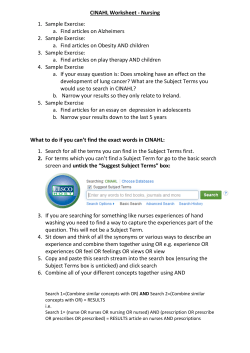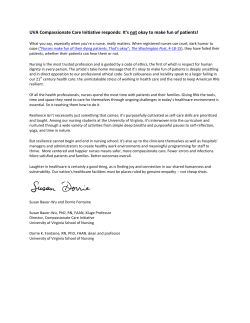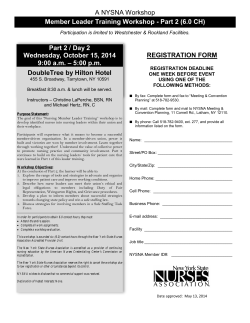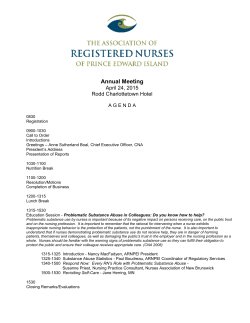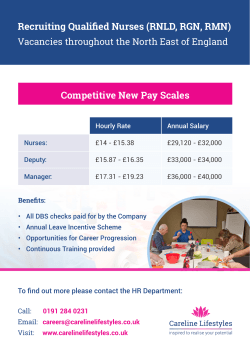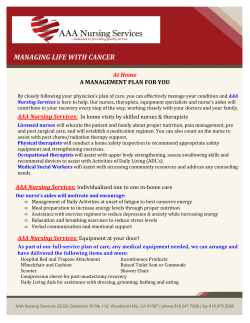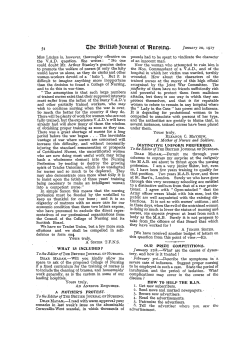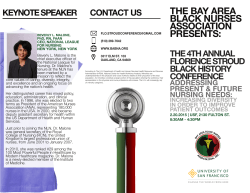
Research Utilization among Nurses at a Teaching Hospital in Kenya
Journal of Caring Sciences, 2015, 4(2), 95-104 doi:10.15171/jcs.2015.010 http:// journals.tbzmed.ac.ir/ JCS Research Utilization among Nurses at a Teaching Hospital in Kenya Albanus Kyalo Mutisya1*, Anna KagureKarani2, Christine Kigondu3 1 Depertment of Nursing, Faculty of Nursing, Jomo Kenyatta University of Agriculture and Technology, Nairobi, Kenya Depertment of Nursing, Faculty of Nursing Sciences, College of Health Sciences, University of Nairobi, Nairobi, Kenya 3 Faculty of Medicine, College of Health Sciences, University of Nairobi, Nairobi, Kenya 2 ARTICLE INFO ABSTRACT Article Type: Original Article Introduction: In the era of evidence based practice (EBP), health care delivery should be grounded on new or validated knowledge and evidence from research. The aim of the study was to assess research utilization by nurses and the influencing factors at Kenyatta National Hospital (KNH), the largest teaching hospital in Kenya. Methods: The study employed a descriptive design that utilized both quantitative and qualitative methods of data collection. It incorporated the Barriers to Research Utilization Scale. It was conducted in six specialized care areas at KNH. Data was collected using questionnaires, Focus Group Discussion and in-depth interviews. Data was analyzed using SPSS version 13 and qualitative data analyzed using themes. Results: The study found that 20.6% of the nurses were participating in research related to their work and 53.6% of these were implementing research findings to practice. Over 2/3 (70.5%) of the respondents were basing their evidence for practice on the knowledge gained during their nursing school. The three greatest barriers to research utilization were that research reports are not readily available (68.7%), unclear implications for practice (66.5%) and inadequate facilities for implementation (66.4%). Conclusion: It is recommended that sensitization trainings on nursing research/ utilization of findings in nursing practice be established to create awareness, motivate and enhance nurses’ abilities and also facilities should be provided to enable implementation. Article History: Received: 30 Jan. 2015 Accepted: 5 Apr. 2015 ePublished: 1 Jun. 2015 Keywords: Nursing research Research utilization Evidence based nursing Practice Introduction The current health care practices require evidence in order to justify actions. Knowledge gained from undertaking nursing research is used to provide evidence besides leading to improvement in the quality of care. Nurses need to devise ways of making nursing interventions cost-effective. Evidence Based Practice (EBP), which is the deliberate use of available evidence when making decisions about the care of individual patients, has proved very useful in nursing practice. It combines information about research results, clinical expertise, patient concerns and patient preferences.1 Regulatory authorities and many health care institutions have realized EBP as the best way to the provision of quality, cost-effective, safe and compassionate health care.2 In order to meet the changing needs of both consumers and providers of health care, nurses need to shift from traditional practices to evidence-driven health care services.3 The International Council of Nurses has been in the forefront in supporting use of research findings by nurses to inform evidence-based practice.4 Studies done in United Kingdom, United States of America and other developed countries have found mixed results about nurses’ utilization of research findings in practice. However, great advances have been made in these countries. In Sweden, nurses are required to perform care based on * Corresponding Author: Albanus Kyalo Mutisya (PhD), email: makxkyalo@yahoo.com. Copyright © 2015 by Tabriz University of Medical Sciences Mutisya et al. research findings and best experiences.5 Many health care institutions in different countries have adopted evidence-based practice and developed initiatives to advance provision of health care based on best evidence rather than on tradition.2 Several studies have been done that utilized the Barriers Scale and investigating nurses’ utilization of research results in nursing practice. Some of the identified determinants include beliefs and attitudes, involvement in research activities, information seeking, professional characteristics, education and other socioeconomic factors.1 Participatory management, an academic degree, education, availability of relevant research, time, positive attitudes and mentorship have also been shown to have a positive relationship with nurses’ likelihood to undertake and use research in practice.6, 7,8 Literature shows gaps in knowledge, conduct of nursing research and use of research findings to improve patient care practices. Varied reasons are cited for non-utilization of research findings in practice.1 Some of the reported barriers to research utilization in the studies that have utilized the barriers scale include lack of resources, time, inadequate authority to change practice, results not being generalizable to own setting and unavailability of research findings.9-11 Despite the emphasis and benefits associated with nursing research and EBP, few nurses utilize research findings to inform nursing practice and especially in developing countries. This is especially important in specialized care units owing to the special nature of the care provided which needs to be based on evidence. Use of research in practice remains poor.12 Little is known about the basis of evidence for nursing practice. According to WHO,13 most research activities in Africa are linked to educational or academic programmers and it is not known how much nursing research is being utilized to improve nursing practice in order 96 | Journal of Caring Sciences, Jun 2015; 4 (2), 95-104 to ensure high quality of health care delivery to improve standards and quality of life. Studies recommend assessment of research utilization and the influencing factors so that barriers can be effectively addressed and the concepts incorporated into practice. In Kenya, utilization of research in nursing practice has not been studied despite its prescription in the scope of practice for nurses by Nursing Council of Kenya.14 There is knowledge gap as to why this is happening despite the advancement in nursing education. Without utilizing nursing research findings, nursing knowledge will stagnate. Modalities to improve standards of nursing practice in Kenya need to be identified and especially in the largest teaching hospital. The study therefore set to assess research utilization and the influencing factors at this teaching hospital in Kenya so as to devise measures of strengthening and enhancing evidence based nursing practice. Materials and methods The study employed a descriptive design and utilized mixed methods of data collection. The study utilized the Barriers’ Scale to identify barriers to research utilization. These included six specialized care units: Intensive care unit, Burns unit, Renal unit, Cardiology unit, Operating Theatres and Emergency Department at Kenyatta National Hospital which is the largest referral and teaching hospital in Kenya. Many nurses undergo their training in this institution after which they are deployed to other parts of the country where they replicate their knowledge and skills. This involved all nurses working as clinicians, administrator’s oras clinical instructors or tutors with an experience of at least one year post nursing school training. The hospital has 1600 nurses in total with 340 deployed to the specialized care units. The formula by Fischer’s et al., was used to arrive at a sample of 180 nurses. Simple random sampling method was used to obtain Copyright © 2015 by Tabriz University of Medical Sciences Among nurses research utilization the proportionate sample from each specialized care unit (ICU–56; Burns unit–16; Renal unit–16; Cardiology unit–5; Operating room–42; Emergency department - 48) The included all nurses whether male or female working in either of the specialized care units with a minimum nursing experience of at least one year. Those on leave during the time of study were excluded. The main tool of data collection was a selfadministered questionnaire. The question naire sought information on nurses’ demographic characteristics and their use of research findings in practice. It incorporated the 29-item Barriers Scale.15 Participants completed the questionnaire at work. A Focus Group Discussion and in-depth interviews were also carried out to obtain qualitative data. The completed questionnaires were examined daily for completeness and properly completed questionnaires were entered into computer and analyzed using SPSS version 13. Frequencies were obtained for nurses’ demographic characteristics, use of research in practice and Barriers Scale ratings. The strength of relationships between variables was determined using bivariate correlations. Results were then presented in form of tables, figures and narrative. Approval was sought from the Ethics and Research Committee of KNH and University of Nairobi and a clearance permit obtained from the National Commission for Science, Technology and Innovation. Permission to use the barriers scale was obtained from Sandra G. Funk by submitting a signed form that is available online. Permission was obtained from KNH Research and Programs Department. Participation was voluntary and a written consent was obtained from each participant. The questionnaires were serialized and the respondents were not required to write their names or any other identification numbers. Information provided was treated with utmost confidentiality and Copyright © 2015 by Tabriz University of Medical Sciences this was communicated respondents. to all the Results In total, 183 nurses from the specialized care units were involved in filling the questionnaires. All of them returned the questionnaires representing a 100% response rate. However, 6 questionnaires were incompletely filled. Table 1 (Part A and B) shows the participants’ characteristics. Females were more (74%) than males (26%). The mean age was 39 years (range 28 – 57 years). Majority (40%, 73) was in the age bracket of 32–43 years. Seventy four percent of the respondents were Kenya Registered Community Health Nurses. Most (30.6%, 56) of the respondents came from ICU, with 25.7%, (47) from Accident & Emergency department and 21.9%, (40) from Operating theatres. More than half (64.5%, 118) had a nursing experience of between 10 and 20 years. Over three quarters (76.5%, 140) were either nursing officer 1 or senior nursing officers. Only 37 (20.6%) indicated having done a research other than the one they did at nursing school while 20.8% were participating in research related to their work (Table 2). More than half (53.6%) of those respondents participating in research related to their work indicated implementing research findings to practice. Forty percent of these researches were local surveys and their application led to improvements in practice or solved an existing problem. A minority (11.9%) read journals weekly or fortnightly while a majority (67.8%) took more than a month to read one. Twenty percent rarely or never read journals at all. The main reasons given for not implementing research findings in practice were that no researches done and /or no feedback are given after doing research. More than three quarters (77%) appreciated that researches add value to practice. Journal of Caring Sciences, Jun 2015; 4 (2), 95-104|97 Mutisya et al. Asked to indicate their basis of evidence for nursing practice, 70.7% cited knowledge gained during nursing school training while 65.2% relied on experience gained at the work place. About a quarter or less were relying on knowledge from either doing research or reading research findings from journals (Figure 1). Accessibility to journals or journal articles was indicated as a major barrier to using findings is practice owing to low or no subscription (70%, 128). Table 1. (Part A) Demographic characteristics of the respondents (n=183) Variable Age (years) Median (min, max) 37 (28, 57) Mean (SD) 39 (8.4) Sex Female Nursing qualification Enrolled nurse Kenya registered nurse/midwife Kenya Registered Community Health Nurse Bachelor of science nurse Master of science in nursing Nursing experience (years) 2-4 5-9 10-15 16-20 21-25 Over 25 Position Senior nursing officer Nursing officer 1 Nursing officer 2 Nursing officer 3 N (%) 135 (74) 18 (10) 6 (3.3) 136(75.6) 17 (9.4) 3 (1.7) 6 (3.3) 31 (16.9) 83 (45.4) 35 (19.1) 18 (9.8) 10 (5.5) 9 (4.9) 131 (71.6) 24 (13.1) 19 (10.4) Table 1. (Part B) Demographic characteristics cont Variable Major role Direct patient care Administration/nursing policy Implementation Clinical instruction/teaching Infection control Health promotion Research Work station Intensive care unit Accident and emergency Renal unit Burns unit Cardiac unit Operating theatres Other courses done Specialized 1 yr course Short courses None 98 | Journal of Caring Sciences, Jun 2015; 4 (2), 95-104 N (%) 158 (86.3) 57 (31.1) 20 (10.9) 27 (14.8) 30 (16.4) 8 (4.4) 56 (30.6) 47 (25.7) 18 (9.8) 17 (9.3) 5 (2.7) 40 (21.9) 53 (29.5) 69 (37.7) 60 (32.8) Copyright © 2015 by Tabriz University of Medical Sciences Among nurses research utilization Table 2. Research activities and utilization Variable Done research Yes No Total Frequency of participating in research related to your work Very often Often Rarely Not at all Total Frequency of reading journals >Monthly Weekly & fortnightly Rarely Never Total Implementing research findings at work place Yes No No response Total Whether researches add value to practice Yes No No response Total Frequency % 37 143 180 20.6 79.4 6 32 116 27 181 3.3 17.5 63.4 14.8 120 21 15 21 177 67.8 11.9 8.4 11.9 98 61 24 183 53.6 33.3 13.1 141 20 22 183 77 10.9 12 Figure1. Evidence basis for nursing practice Copyright © 2015 by Tabriz University of Medical Sciences Journal of Caring Sciences, Jun 2015; 4 (2), 95-104|99 Mutisya et al. Professional qualification, having undertaken a post basic training or a short course and work station were shown to have a significant positive association with utilizing research findings in practice (P < 0.05). Also, being in an administrative position or clinical instruction role showed significant positive association with research utilization. However, sex, years of nursing experience, position held and even the level of research knowledge had no significant association with utilizing research findings in practice. The greatest barriers to research utilization according to the ratings in the Barriers Scale were those related to accessibility and communication/presentation of the research 2.84 (1.05) with three of the top six barriers falling in this category (Table 3). The major barrier cited was unavailability of research reports (68.7%), followed by implications for practice not being clear (66.5%) and facilities being inadequate for implementation (66.4%). Characteristics of the organization featured prominently encompassing lack of time, support, authority to change practice and generalizability of results 2.99 (1.19). Table 3. Barriers to Research Utilization Scale Ratings (Adapted from Sandra Funk et al, 1991; Scale: 1-no extent 2-little extent 3-moderate extent 4-great extent) Barriers scale items Factor 1: Characteristics of the adopter (The nurse’s research values, skills, awareness) The nurse is unwilling to change/try new ideas. The nurse is unaware of the research. The nurse feels the benefits of changing practice will be minimal. The nurse sees little benefit for self. The nurse does not feel capable of evaluating the quality of the research. The nurse is isolated from knowledgeable colleagues with whom to discuss the research. There is not a documented need to change practice. The nurse does not see the value of research for practice. Factor 2: Characteristics of the organization (Setting, barriers, limitations) The facilities are inadequate for implementation. The nurse does not feel she/he has enough authority to change patient care procedures. The nurse feels results are not generalizable to own setting. The nurse does not have time to read research. Other staffs are not supportive of implementation. Physicians will not cooperate with implementation. There is insufficient time on the job to implement new ideas. Administration will not allow implementation. Factor 3: Characteristics of the innovation (Qualities of the research) Research reports/articles are not published fast enough. The research has not been replicated. The research has methodological inadequacies The nurse is uncertain whether to believe the results of the research. The literature reports conflicting results. The conclusions drawn from the research are not justified. Factor 4: Characteristics of the communication (Presentation and accessibility of the research) Research reports/articles are not readily available. Implications for practice are not made clear. Statistical analyses are not understandable. The amount of research information is overwhelming The relevant literature is not compiled in one place. The research is not reported clearly and readably. The research is not relevant to the nurse’s practice. N N (%)* Mean (SD) Overall item rank 2.70 177 179 175 178 176 176 99 (56) 97 (54.2) 95 (54.3) 93 (52.3) 86 (48.9) 83 (47.2) 2.81 (1.17) 2.86 (1.24) 2.74 (1.20) 2.76 (1.25) 2.73 (1.24) 2.65 (1.25) 11 13 12 15 18 20 177 177 77 (43.5) 64 (36.1) 23 27 176 174 117 (66.4) 113 (65) 2.71 (1.30) 2.35 (1.21) 2.99 (1.19) 3.23 (1.11) 3.09 (1.20) 177 177 176 176 175 174 108 (61) 105 (59.3) 102 (58) 99 (56.3) 94 (53.7) 80 (46) 7 8 9 10 14 22 176 176 178 177 177 176 112 (63.7) 89 (50.6) 85 (47.8) 81 (45.8) 74 (41.8) 67 (38) 2.93 (1.09) 2.93 (1.13) 3.01 (1.20) 3.18 (1.27) 2.91 (1.25) 2.67 (1.28) 2.80 3.17 (1.17) 2.95 (1.28) 2.82 (1.25) 2.63 (1.22) 2.72 (1.35) 2.53 (1.26) 2.84 (1.05) 179 179 179 176 176 178 176 123 (68.7) 119 (66.5) 112 (62.5) 90 (51.1) 86 (48.9) 71 (39.9) 47 (26.7) 3.21 (1.06) 3.23 (1.08) 3.08 (1.12 2.78 (1.23) 2.85 (1.27) 2.51 (1.28) 2.20 (1.34) 1 2 6 16 18 25 28 3 4 5 17 19 21 24 26 * Reporting item as moderate/great barrier 100 | Journal of Caring Sciences, Jun 2015; 4 (2), 95-104 Copyright © 2015 by Tabriz University of Medical Sciences Among nerses research utilization by nurses Respondents in the in-depth interviews mentioned inconsistent knowledge/skills of research and information search and indicated the need for creating awareness among the nurses. Lack of mentorship and motivation also emerged as major setbacks. Participant No 7: “Nurses need to be informed or updated with knowledge to know how to start off and also made aware of research opportunities.” Participant No 13: “Nurses lack training in research.” Participant No 9: “Nurses need extra training.” Participant No 1: “Give nurses knowledge /Trainings showing them it is not difficult. Simplify it for them. Let them know they can do it.” Carrying out research/utilizing findings is not emphasized in the work place. It is not considered as part of the job description. Participant No 13 and 14: “There is no support for nurses to do research. Participants No 3 and 4: “There is lack of team approach. Nurses generally don’t have interest to do things together. There is lack of support from fellow nurses.” Following feedback given to the management of this hospital after this survey, a program has already been started in the institution to support research by availing research funds and training researchers. Nurses showed a lot of enthusiasm to base their practice on research findings. However, few nurses were motivated to do research. Also, there are no mentors in nursing research. Participant No 14:“There is no mentoring for nurses who wish to do research.” Nurses are overwhelmed by the much work that they have to do owing to shortage of staff. Time factor was identified by almost all the participants in the indepth interviews. Participant No 7 and No 10: “The kind of work is demanding. There is no time as you are fatigued at end of the day.” All respondents appreciated the importance of utilizing research findings in practice and especially for evidence based Copyright © 2015 by Tabriz University of Medical Sciences practice which lead to improvement in the care of patients and provision of rationales for nursing care interventions. Almost all participants (n =12) indicated the need for appropriate mentoring and an organized approach in creating a research culture among the nurses. Discussion The study found that, 20.6% of the respondents had done a research other than the one they did at nursing school and 20.8% were participating in research related to their work. About half (53.6%) of these had implemented research findings in practice and this led to improvements in practice or solved an existing problem. This concurs with the emphasis by Mehrdad and Salsali,16 that utilizing research results in practice translates into efficiency, effectiveness and quality improvement in health care. Over 70% of the respondents were basing their evidence for practice on knowledge gained during nursing school training while 65.2% relied on experience gained at the work place. While useful experiences are good for replication, this may sometimes lead to practices steeped in tradition which may not be useful to recipients of care. About a quarter or less were basing their evidence for practice on their own research findings or reading journal articles. It is apparent that if nurses do not use research findings in practice, then the benefits associated with it will be denied to the clients seeking health services. The results show the greatest barriers to research utilization were related to the accessibility and availability of research results, unclear implications for practice and inadequate facilities. In fact respondents cited that few nurses engage in research and the findings of those few are not made available. The results are in agreement with previously published researches regarding utilization of research Journal of Caring Sciences, Jun 2015; 4 (2), 95-104|101 Mutisya et al. findings by nurses and factors that act as barriers. Yaya et al.,9 found the most important barriers in Turkey as inadequate authority, lack of time and insufficient facilities. Patiraki et al.,10 in Greece found the two key barriers were related to the availability of research findings while Carrion et al.,11 in Spain reported barriers related to the applicability of research results to own settings besides characteristics of the organizations where nurses worked and characteristics of the nurses themselves. In UK, Closs et al.,17 found time, facilities and cooperation from colleagues as the greatest areas of concern. In the same country, Garish and Lacey18 found engaging nurses in research or utilizing findings in practice an extremely difficult concept in the initial stages but these were gradually adopted. In China, Sing-Ling Tsai19 found low participation in research but nearly half of the nurses had utilized research to change practice in the preceding 3 years. The main barriers were lack of time and staff. In this study, respondents showed significant understanding of the importance of research in nursing practice and especially for evidence based practice. Nurses also reported lack of adequate knowledge, time, mentorship, and administrative support as other barriers to their research activities. These findings are similar to those found by Mehrdad and Salsali,16 in Iran and by Kuupelomaki and Tuomi in Finland.20 Majority (over 80%) of respondents indicated the need to be sensitized on and supported in research activities and utilization of research findings in practice. barriers to utilization of research findings in practice. The findings from some of the researches done were utilized in practice and this led to improvements. The respondents showed great understanding of the importance of research in nursing practice and more so for evidence based practice. They expressed great interest to be facilitated to carry out research and/or use findings in practice. There was a significant positive association between utilizing research findings in practice and nursing qualification, post basic training and work station. However, nurses cited the major barriers to utilizing findings in practice as the unavailability of research reports, unclear implications for practice and inadequate facilities. Also, inconsistent knowledge or skills, lack of time, support, motivation and results that are not generalizable to local setting were other barriers cited. These need to be addressed and especially for nurses in developing countries where 84% of the worlds’ population live and which account for 93% of the word wide burden of disease.19 There is need to design strategies to support nurses’ involvement in research and utilization of research findings in practice so as to enhance evidence based practice in health care systems in Kenya.The significance of nursing research and utilization of findings in practice needs to be emphasized during nurses’ training period and incorporated in nurses’ induction programs. Sensitization trainings on nursing research or utilization of findings in nursing practice are established to create awareness, motivate and enhance nurses’ abilities and improve practice. Acknowledgments Conclusion The study established the proportion of nurses utilizing research findings in practice and the evidence that they based their practice on. It also identified various 102 | Journal of Caring Sciences, Jun 2015; 4 (2), 95-104 Much appreciation to Partnerships for Innovative Medical Education in Kenya (PRIME-K/MEPI), NIH Grant Number 5R24 TW008889-02 for providing seed grant for this research project and Jomo Kenyatta Copyright © 2015 by Tabriz University of Medical Sciences Among nurses research utilization University of Agriculture and gratitude to the management National Hospital and all participated in this study as and data collectors. Technology, of Kenyatta those who respondents Ethical issues None to be declared. Conflict of interest The authors declare no conflict of interest in this study. References 1. Johansson B, Fogelberg-Dahm M, Wadensten B. Evidence-based practice: the importance of education and leadership. J Nurs Manag 2010; 18 (1):70–7. doi: 10.11 11/j.1365-2834. 2009.01060. 2. Brown CE, Wickline MA, Ecoff L, Glaser D. Nursing practice, knowledge, attitudes and perceived barriers to evidence-based practice at an academic medical center; J Adv Nurs 2009; 65 (2): 371–81. doi: 10.1111/j.1365-2648. 2008. 04878. 3. Roxburg M. An exploration of factors which constrain nurses from research participation; J Clin Nurs 2006, 15 (5): 535-45. 4. Nature and scope of practice of nurse – midwives. 2007; Available from: http://www.icn.ch/images/stories/documen ts/publications/position_statements/A10_N ature_Scope_Practice_Nurse-Midwives. 5. Socialstyrelsen. Kompetens beskrivning för legitimerad sjuksköterska. 2005; Available from: http://www. Socialstyrel sen.se/ lists/artikelkatalog/ atta chments/ 9879/2005-105-1_20051052.pdf. 6. Estabrooks CA, Floyd JA, Scott-Findlay S, O'Leary KA, Gushta M. Individual determinants of research utilization: a systematic review. J Adv Nurs 2003; 43 (5), 506-20. Copyright © 2015 by Tabriz University of Medical Sciences 7. Hutchinson AM, Johnston L. Bridging the divide: a survey of nurses' opinions regarding barriers to, and facilitators of, research utilization in the practice setting. J Clin Nurs 2004; 13 (3): 304-15. 8. Kajermo KN, Undén M, Gardulf A, Eriksson LE, Orton ML, Arnetz BB, Nordström G. Predictors of nurses’ perceptionsof barriers to research utilization. J Nurs Manag 2008; 16 (3): 305-14. doi: 10.1111/j.1365-2834. 2007. 00770.x. 9. Yava A, Tosun N, Çiçek H, Yavan T, Terakye G, Hatipoğlu S. Nurses Perceptions of the barriers to and facilitators of research utilization in Turkey. Applied Nursing Research 2009; 22 (3): 166-75. 10. Patiraki E, Chrysoula K, Despina P, Ageliki S, Chrysoula K, Elpida B, Anastasios M. Barriers in implementing research findings in cancer care: the Greek registered nurses perceptions. European Journal of Oncology Nursing 2004, 8 (3), 245-56. 11. Carrion M, Woods P, Ian Norman. Barriers to research utilization among forensic mental health nurses. Int J Nurs Stud 2004; 41 (6): 613-9. 12. Olade RA. Evidence based practice and research utilization among rural nurses. J of Nurs Scholarship 2004; 36 (3): 22025. 13. McKay N, Al-Gasseer N, Vonderheid S, Abou Youssef E, Persaud V, Adams O. Strengthening nursing and midwifery progress and future directions, summary document 1996–2000. 2001; Geneva: World Health Organization. Available from: http://apps.who.int/ iris/ bitstream/ 10665/67125/ 1/WHO _EIP_ OSD 2001 . 5. Pdf. 14. Scope of Practice for Nurses in Kenya. 3rd ed; 2012. Nairobi: Nursing Council of Kenya. Available from: http:// nckenya. com/ what-we-do/mandate. Journal of Caring Sciences, Jun 2015; 4 (2), 95-104|103 Mutisya et al. 15. Funk SG, Champagne MT, Wiese RA, Tornquist EM. Barriers: The barriers to research utilization scale. Appl Nurs Res 1991; 4 (1): 39-45. 16. Mehrdad N, Salsali M, Kazemnejad A. The spectrum of barriers toand facilitators of research utilization in Iranian nursing. J Clin Nurs 2008; 17 (16): 2194-202. doi: 10.1111/j.13652702.2007.02040.x. 17. Closs SJ, Baum G, Bryar RM, Griffiths J, Knight S. Barriers to research implementation in Yorkshire hospitals. Clinical Effectiveness in Nursing 2002; 104 | Journal of Caring Sciences, Jun 2015; 4 (2), 95-104 4 (1): 3-10. doi: 10. 1054/ cein. 2000 .0100. 18. Gerrish k, Lacey A. The research process in nursing. 2006; 6th ed. Uk: WileyBlackwell. 19. DiCenso A, Cullum N, Ciliska D. Implementing evidence- based nursing: some misconceptions. Evid Based Nurs 1998; 1: 38–40. doi:10.1136/ebn.1.2.38. 20. Kuuppelomäki M, Tuomi J. Finish nurses’ attitudes towards nursing research and related factors; Int J Nurs Stud 2005; 42 (2): 187-96. Copyright © 2015 by Tabriz University of Medical Sciences
© Copyright 2025
